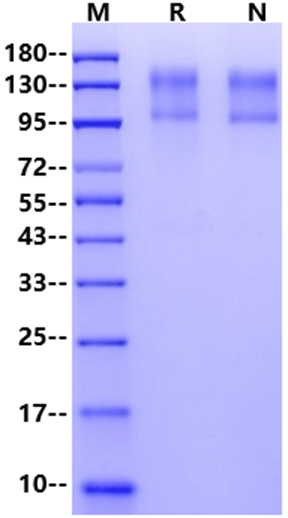Gln26-Lys577, with C-terminal 10*His
QSPTPSPTGLTTAKMPSVPLSSDPLPTHTTAFSPASTFERENDFSETTTSLSPDNTSTQVSPDSLDNASAFNTTGVSSVQTPHLPTHADSQTPSAGTDTQTFSGSAANAKLNPTPGSNAISDVPGERSTASTFPTDPVSPLTTTLSLAHHSSAALPARTSNTTITANTSDAYLNASETTTLSPSGSAVISTTTIATTPSKPTCDEKYANITVDYLYNKETKLFTAKLNVNENVECGNNTCTNNEVHNLTECKNASVSISHNSCTAPDKTLILDVPPGVEKFQLHDCTQVEKADTTICLKWKNIETFTCDTQNITYRFQCGNMIFDNKEIKLENLEPEHEYKCDSEILYNNHKFTNASKIIKTDFGSPGEPQIIFCRSEAAHQGVITWNPPQRSFHNFTLCYIKETEKDCLNLDKNLIKYDLQNLKPYTKYVLSLHAYIIAKVQRNGSAAMCHFTTKSAPPSQVWNMTVSMTSDNSMHVKCRPPRDRNGPHERYHLEVEAGNTLVRNESHKNCDFRVKDLQYSTDYTFKAYFHNGDYPGEPFILHHSTSYNSKGGGSGGGSHHHHHHHHHH
95-150kDa (Reducing)
Reconstitute at 0.1-1 mg/ml according to the size in ultrapure water after rapid centrifugation.
1.CD45 in human physiology and clinical medicine. Immunol Lett. 2018 Apr;196:22-32. Epub 2018 Jan 31.
CD45 is an evolutionary highly conserved receptor protein tyrosine phosphatase exclusively expressed on all nucleated cells of the hematopoietic system. It is characterized by the expression of several isoforms, specific to a certain cell type and the developmental or activation status of the cell. CD45 is one of the key players in the initiation of T cell receptor signaling by controlling the activation of the Src family protein-tyrosine kinases Lck and Fyn. CD45 deficiency results in T- and B-lymphocyte dysfunction in the form of severe combined immune deficiency. It also plays a significant role in autoimmune diseases and cancer as well as in infectious diseases including fungal infections. The knowledge collected on CD45 biology is rather vast, but it remains unclear whether all findings in rodent immune cells also apply to human CD45.

1μg (R: reducing condition, N: non-reducing condition).

Immobilized CD45 His Tag Protein, Human (Cat. No. UA010556) at 2.0μg/mL (100μL/well) can bind CD45 Mouse mAb (S-839-3) (Cat. No. S0B0427) with EC50 of 2.38-2.62ng/mL.